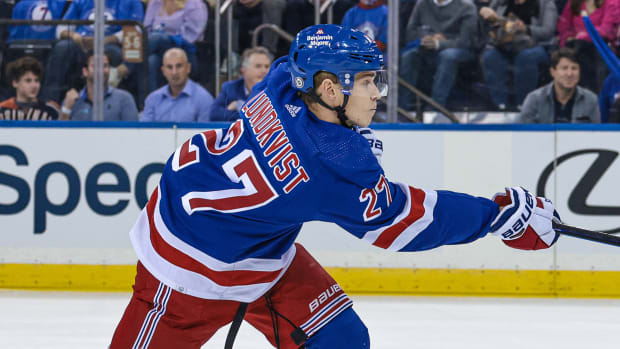Faced with having too many good young defensemen, the New York Rangers were dealing with one of hockey’s best problems so they made a trade.
On Monday, Rangers sent promising 22-year-old blueliner Nils Lundkvist to the Dallas Stars for a conditional first-round pick (top-10 protected in 2023, unprotected in 2024) and a conditional fourth-round pick in 2025 (becomes a third-rounder in 2025 if Lundkvist totals 55 points the next two seasons).
The Rangers are getting some draft capital for the future and helping clear out a spot in their prospect pool that is already loaded with defensive prospects such as Braeden Schneider, Zac Jones, and Matthew Robertson among others.
So, what are the Stars getting in this deal?
Drafted 28th overall in the 2018 draft after a strong season in Sweden, splitting time between the junior and SHL level, Lundkvist showed puck-moving potential and the ability to run a powerplay with ease and efficiency. Despite being undersized, his defensive game showed plenty of potential as he positioned himself intelligently, utilizing his skating to its fullest ability.
After being drafted, the young Swede spent most of his time in the SHL and showcased how effective his game could be against men. His offensive game would progress year over year, with his point totals improving each season. Lundkvist’s game matured all over the ice, rounding out his game in his own end as well as becoming more engaged in transition, joining the rush and making plays through the middle of the ice more consistently.
Making the trek to North America last season, Lundkvist made the team out of training camp and looked like an effective player but lacked the offensive proficiency and puck-moving ability that he had come to be known for. Lundkvist played a more conservative game, showcasing his defensive intelligence. The coaching staff wanting the reigned-in version of his game took what was special about Lundkvist out of him. The Rangers often asked their young players to play simple hockey and while Lundkvist was always efficient and well-rounded, he brought dynamism and pace-pushing ability to the game.
His lack of production meant that he was sent down to the AHL and left to figure his game out there, in a similar system with less talent around him. Not an ideal situation for a player who attempts to make life difficult on his opponent by taking away space with his speed and effective stick in the defensive end and then move the puck up to the neutral zone before joining the rush to provide supplemental support.
After never receiving another call-up to the NHL, the writing was on the wall. Lundkvist’s future with New York was a question mark and then a trade request made public less than a week ago made it certain he was on the way out.
Now with the Stars, Lundkvist is looking forward to a fresh start. Dallas’ general manager has stated his desire to have a more even left-right split going into the season and Lundkvist certainly helps with that. Only Jani Hakanpää and Colin Miller shoot right-handed on the Stars blueline as of right now with only Hakanpää set to be a surefire top-six blueliner for the club on opening night. Lundkvist should be on the Stars roster without issue and should earn himself top-four minutes with the club. Powerplay time isn’t out of the question either.
In a system more conducive to offensive creation, Lundkvist’s puck-moving ability should be more evident. He has the ability to get maneuver his way out of trouble on his own end and skate the puck up ice. The Swedish rearguard is confident with the puck on his stick, weaving through the neutral zone with strong puck skill and high-end route recognization. With so much of the breakout laid on the shoulders of Stars’ defender Miro Heiskanen, Lundkvist will be a welcome addition to the blueline.
His game is more complete than many people give him credit for. He lacks the physicality of an old-school defensive blueliner but he remains a positive defensive impact player because of his ability to out-skill and out-skate opponents.
In the offensive zone, Lundkvist activates from the blueline to create an offensive chance but does so with a high rate of success. He doesn’t often get burned when he attacks down the wall or penetrates the slot, understanding when to pick his spots. When Lundkvist does find himself below the dots as the puck starts the other way, he uses his crisp skating stride to accelerate through space and regain defensive position, understanding which role he needs to fill on the defensive transition.
Lundkvist is an excellent passer in all three zones, using his forehand and backhand to send the puck to teammates. He rarely seems hemmed into a corner because of that ability, identifying passing lanes and understanding how to use the boards to send a pass around opponents or playing the give-and-go with precision. Lundkvist has the innate ability to read the ice surface and exploit the openings presented to him.
Where Lundkvist winds up in the lineup in Dallas is still a question. He has all of the skill to play in their top-six and could be presented with the opportunity to play with Heiskanen at some point as the right-shot partner that the Stars are in search of.
The Stars should be in a position to give Lundkvist the minutes he needs to showcase the player he was at the SHL level. His maturation over the last couple of seasons should make him an effective NHLer with a modern defensive game and complete transitional game. His offensive game is dynamic without being unnecessarily complicated. There’s a lot to like about Lundkvist’s game and we should get to see the full nature of his ability with the Stars this season.



